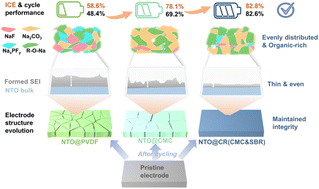Enabling both ultrahigh initial coulombic efficiency and superior stability of Na2Ti3O7 anodes by optimizing binders†
Abstract
Na2Ti3O7 (NTO) anodes with an ultra-low voltage plateau of 0.3 V have broad application prospects. However, the critical issues of low initial coulombic efficiency (ICE) and cycling instability severely hamper their practical applications, and it was difficult to simultaneously improve both in previous studies by doping or carbon coating, especially for an ideal ICE. Unexpectedly, we reported that this can be fulfilled simply by optimizing the binder carboxymethyl cellulose and styrene butadiene rubber (CMC and SBR, CR). The ICE can be significantly improved from 58.6% with common polyvinylidene fluoride (PVDF), to 78.1% with CMC and to the final 82.8% with CMC and SBR. Moreover, the superior coulombic efficiency of each subsequent cycle endows NTO with impressive cycle stability (100th capacity retention of 82.6%) and rate capability (84 mA h g−1 at 10C). The superior performance can be ascribed to both strong mechanical strengths (firm inter-particle cohesion and adhesion between the electrode-film and current collector) to maintain electrode integrity and high-quality solid electrolyte interphase (SEI) film that prevents continuous electrolyte decomposition. Emphatically, more details about the effects of these three binders on the electrode structure, interface properties, and ion storage characteristics were investigated in depth.



 Please wait while we load your content...
Please wait while we load your content...